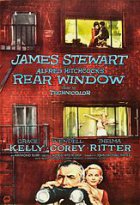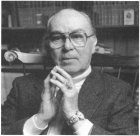
Rear Window Page #2
- PG
- Year:
- 1954
- 112 min
- 7,029 Views
THE CAMERA PANS to a nearby table on which rests a shattered
and twisted Speed Graphic Camera, the kind used by fast-action
news photographers.
On the same table, the CAMERA PANS to an eight by ten glossy
photo print. It shows a dirt track auto racing speedway,
taken from a point dangerously near the center of the track.
A racing car is skidding toward the camera, out of control,
spewing a cloud of dust behind it. A rear wheel has come off
the car, and the wheel is bounding at top speed directly
into the camera lens.
THE CAMERA MOVES UP to a framed photograph on the wall.
It is a fourteen by ten print, an essay in violence, having
caught on film the exploding semi-second when a heavy
artillery shell arches into a front-line Korean battle
outpost. Men and equipment erupt into the air suspended in a
solution of blasted rock, dust and screeching shrapnel. That
the photographer was not a casualty is evident, but surprising
when the short distance between the camera and the explosion
is estimated. A signature in the lower right hand corner of
the picture reads -- "L. B. Jefferies."
THE CAMERA PANS to a second photograph of a picket line at
an aircraft plant strike. Strikers, non-strikers and police
are embroiled in a bitter and confused riot.
Clubs, fists and truncheons swing, blood flows, faces twist
with emotion and fallen victims struggle to regain their
feet. The picture represents no distant, cautions photographic
observation, but rather an intimate report, so immediate and
real that the viewer has the nervous feeling the fight
surrounds him and he had best defend himself. The same
signature, "L. B. Jefferies," is in the corner.
THE CAMERA PANS TO another framed picture, this one a
beautiful and awesome shot of an atomic explosion at
Frenchman's Flat, Nevada. It is the cul-de-sac of violence.
The picture taken at a distant observation point, shows some
spectators in the foreground watching the explosion through
binoculars.
THE CAMERA MOVES ON to a shelf containing a number of cameras,
photographic film, etc. It then PAN ACROSS a large viewer on
which is resting a negative of a woman's head.
From this, THE CAMERA MOVES ON to a magazine cover, and
although we do not see the name of the magazine, we can see
the head on the cover is the positive of the negative we
have just passed.
THE CAMERA FINALLY COMES TO REST ON a pile of magazines --
perhaps a hundred or so. They are all of the same publication.
LAP DISSOLVE TO:
INT. GUNNISON'S OFFICE - DAY - CLOSE UP
The screen is filled with the top of a desk. In addition to
the usual telephones, blotting pad, etc., the most prominent
feature is the number of glossy photo prints, and even larger-
sized mat prints. Some of them have slips pasted over with
descriptions. The center of the desk is occupied by a large
layout of photographs on one magazine page. Behind this we
hear the murmur of two voices of men who can be vaguely seen
beyond the desk.
THE CAMERA PANS UP and we are now face to face with IVAR
GUNNISON and JACK BRYCE. Gunnison is sitting on a window-
ledge, and beyond him we realize we are high above the New
York streets. Bryce leans against a wall at right angles to
him.
Gunnison is holding a cablegram in his hand. Bryce has a
cigarette in his mouth. He scratches a match, and is about
to light it, when he notices that Gunnison, still reading
the cable, has reached into an inside shirt pocket, and
produced a cigarette. Quickly, Bryce moves over to light
Gunnison's cigarette. Then he settles back to light his own.
Gunnison doesn't even bother to thank him.
GUNNISON:
(Looks up)
Indo-China -- Jeff predicted it would
go sky-high.
BRYCE:
From the looks of Davidson's cable,
it might even go higher than that.
And we haven't even got a camera
over there.
GUNNISON:
(Stands)
This could go off in a month -- or
an hour.
BRYCE:
I'll pull somebody out of Japan.
GUNNISON:
(Heads for his phone)
Bryce, the only man for this job is
sitting right here in town.
(Picks up phone)
Get me L. B. Jefferies.
BRYCE:
(Puzzled)
Jefferies?
GUNNISON:
(To Bryce; still
holding phone)
Name me a better photographer.
BRYCE:
(He can't)
But his leg!
GUNNISON:
Don't worry -- it comes off today.
Bryce gives Gunnison a startled look.
GUNNISON:
I mean the cast.
(To phone)
INT. JEFF'S APARTMENT - DAY - SEMI-CLOSEUP
Shooting through the open window, onto Jeff. He is shaving
himself with an electric razor as the phone rings. He shuts
off the shaver, picks up the phone.
JEFF:
Jefferies.
Translation
Translate and read this script in other languages:
Select another language:
- - Select -
- 简体中文 (Chinese - Simplified)
- 繁體中文 (Chinese - Traditional)
- Español (Spanish)
- Esperanto (Esperanto)
- 日本語 (Japanese)
- Português (Portuguese)
- Deutsch (German)
- العربية (Arabic)
- Français (French)
- Русский (Russian)
- ಕನ್ನಡ (Kannada)
- 한국어 (Korean)
- עברית (Hebrew)
- Gaeilge (Irish)
- Українська (Ukrainian)
- اردو (Urdu)
- Magyar (Hungarian)
- मानक हिन्दी (Hindi)
- Indonesia (Indonesian)
- Italiano (Italian)
- தமிழ் (Tamil)
- Türkçe (Turkish)
- తెలుగు (Telugu)
- ภาษาไทย (Thai)
- Tiếng Việt (Vietnamese)
- Čeština (Czech)
- Polski (Polish)
- Bahasa Indonesia (Indonesian)
- Românește (Romanian)
- Nederlands (Dutch)
- Ελληνικά (Greek)
- Latinum (Latin)
- Svenska (Swedish)
- Dansk (Danish)
- Suomi (Finnish)
- فارسی (Persian)
- ייִדיש (Yiddish)
- հայերեն (Armenian)
- Norsk (Norwegian)
- English (English)
Citation
Use the citation below to add this screenplay to your bibliography:
Style:MLAChicagoAPA
"Rear Window" Scripts.com. STANDS4 LLC, 2025. Web. 6 Mar. 2025. <https://www.scripts.com/script/rear_window_431>.







Discuss this script with the community:
Report Comment
We're doing our best to make sure our content is useful, accurate and safe.
If by any chance you spot an inappropriate comment while navigating through our website please use this form to let us know, and we'll take care of it shortly.
Attachment
You need to be logged in to favorite.
Log In